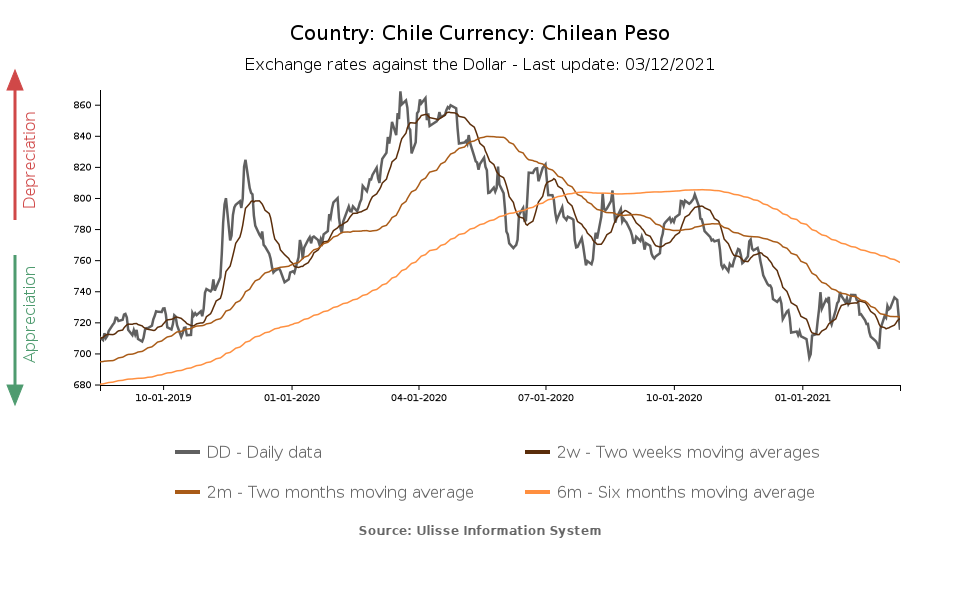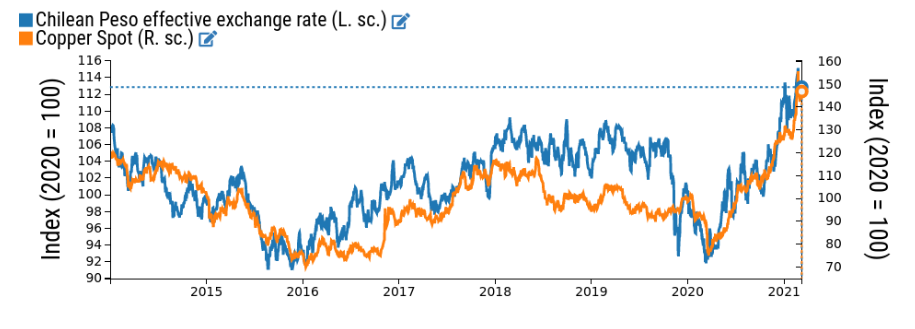Chilean Peso: Copper Price and Vaccine Effect
Published by Alba Di Rosa. .
Exchange rate Uncertainty Exchange rate risk Latin America Covid-19 Emerging markets Exchange ratesIn the panorama of emerging market currencies, we address today the case of the Chilean peso. Looking at its exchange rate against the dollar, we can see that the South American currency is back to the levels of late 2019, before the outbreak of street protests complaining about Chile's high levels of social inequality (see in this regard the article "Chile: street protests, inequality and the Peso"). These protests caused a weakening of the currency, as shown in the chart below, which then subsided by the end of 2019.

During 2020, the peso then dealt with the financial implications of the Covid-19 shock, reacting in line with most EM currencies: an initial depreciation, followed by a recovery from the spring of 2020. In the case of the peso, this recovery was particularly significant and, by year-end, brought the exchange rate against the dollar to levels of greater strength than those seen prior to the onset of the pandemic. Since early 2021, the peso's exchange rate against the greenback has hovered roughly in the range of 700-740 CLP per USD; it closes the week at 715.19 CLP per dollar.
Looking at the effective exchange rate, which is calculated as the weighted average of a basket of bilateral exchange rates against the currency in question, in relation to the country's major trading partners, we can see quite clearly the presence of a rally; in spite of some fluctuations, this trend has been going on since the spring of 2020 and has currently taken the peso to its highest levels in years.
The main elements that are affecting the dynamics of the peso in this period, and are supporting its levels of relative strength, are the efficiency of the vaccination campaign and the copper price rally.
Vaccinations. As for the first point, data on vaccinations administered per 100 inhabitants clearly show that Chile is among the countries in the world that currently have the highest rates of vaccinations per 100 people. The country also stands out compared to its neighbors in Latin America: in the region, outside of Chile, only the Dominican Republic, Panama and Brazil have currently administered just above 5 vaccinations per 100 people - compared to a level greater than 32 for Chile. Among the world's largest countries, Chile is currently preceded in the number of vaccinations only by Israel, the United Arab Emirates and the United Kingdom.
Total vaccinations per hundred people
A rapid vaccination campaign is viewed positively by the markets, as it signals that reopenings, economic recovery and the return to pre-pandemic levels of economic activity can occur in a relatively short time frame, and faster than in other countries1.
Copper price. Another element that should certainly be taken into account when analyzing the dynamics of the Chilean peso exchange rate is the price of copper, a commodity of which Chile is the world's largest exporter (source: ExportPlanning). Indeed, the Chilean currency has historically been sensitive to fluctuations in the price of copper, as shown in the chart below, which shows data on the effective exchange rate of the peso and the spot price of copper listed on the London Metal Exchange, from 2014 to present.
Chilean peso effective exchange rate and copper spot price
Source: DailyDataLab

Between the dynamics of the two series we can see a significant proximity, confirmed also in the last quarters. Indeed, the rally in the effective exchange rate of the peso was accompanied by the rise in the price of copper, which increased in relation to:
- positive market expectations regarding the recovery of the global economy and a full recovery in demand in the coming months, which are currently supporting commodity prices;
- the increase in demand that is expected in connection with developments of the green economy;
- fears of a supply shortage.
Risk elements. Despite the aforementioned supportive elements, one risk element that remains in the outlook for Chile and its currency is politics. As mentioned above, the presidency of the current leader Piñera has been marked by protests, in late 2019 and early 2020, against inequality in the country; although the good management of the vaccination campaign has increased people's approval for the leader, the coming months will be rich from the point of view of the political calendar - an element that could spark interest (as well as tension) on the part of investors. In April, in fact, congressional elections will take place - the new congress will be called upon to write a new constitution -, while presidential elections will be held in November. Financial markets will certainly keep an attentive eye on these developments.
1. The speed of the vaccination campaign compared to European neighbors is an element that is supporting the pound, as well, as reported in a previous article.


